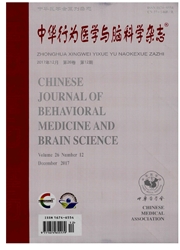

 中文摘要:
中文摘要:
目的:探讨偏头痛患者的风险概率模糊的决策能力是否有改变。方法采用风险概率模糊的爱荷华博弈任务(Iowa Gambling Task,IGT)对22例偏头痛患者和21健康对照组被试进行模糊决策能力的评估。结果与健康对照组相比,偏头痛组患者模糊决策功能受损。表现为:偏头痛组净剩值(-2.64±9.59)低于对照组(9.90±13.89),差异有统计学意义(t=-3.459,P=0.001)。在进行测量的五个block中,两组净剩值在block3(偏头痛组:1.27±4.56;健康对照组:4.29±4.57;F=4.679,P=0.036)、block4(偏头痛组:-2.27±6.39;健康对照组:4.38±5.12;F=14.098,P=0.001)、block5(偏头痛组:-2.18±6.26;健康对照组:4.29±5.34;F=13.222,P=0.001)中的差异具有统计学意义。随着选择数增加,正常对照组净剩值呈不断增加趋势,而偏头痛患者并未表现出此种稳定的决策行为模式。结论偏头痛患者存在模糊决策功能受损。
 英文摘要:
英文摘要:
Objective To observe the ability of decision-making under ambiguity in migraineurs.Methods Iowa Gambling Test was applied in 22 migraineurs and 21 healthy controls (HC) who were matched in age,sex,education,MMSE,HAMD,HAMA,Digit Span Test (DS) with migraineurs.Results As compared with healthy controls,the migraineues were impaired in decision-making under ambiguity.migraineurs scored lower in ITG (Migraineurs:-2.64 ± 9.59,HC:9.90 ± 13.89,t=3.459,P=0.001).A comparison between the scores of subjects on 5 blocks showed:Migraineurs scored lower on block3(Migraineurs:1.27± 4.56;HC:4.29± 4.57;F=4.679,P=0.036),block4(Migraineurs:Migraineurs:-2. 27 ± 6.39;HC:4.38 ± 5.12;F=14.098,P=0.001) and block5 (Migraineurs:-2.18 ± 6.26;HC:4.29 ± 5.34;F=13.222,P=0.001 ).The HC scored higher as the game progresses,while the migraineurs didn’t exhibit this stable advantageous shift in decision-making.Conclusion The migraineurs have significant deficit of decision-making under ambiguity .
 同期刊论文项目
同期刊论文项目
 同项目期刊论文
同项目期刊论文
 Dissociation of decision making under ambiguity and decision makingunder risk: A neurocognitive endo
Dissociation of decision making under ambiguity and decision makingunder risk: A neurocognitive endo Selective impairment of attention networks in breast cancer patients receiving chemotherapy treatmen
Selective impairment of attention networks in breast cancer patients receiving chemotherapy treatmen Dissociation of decision making under ambiguity and decision making under risk: A neurocognitive end
Dissociation of decision making under ambiguity and decision making under risk: A neurocognitive end Trait-related decision making impairment in obsessivecompulsive disorder: evidence from decision mak
Trait-related decision making impairment in obsessivecompulsive disorder: evidence from decision mak Dissociation of Neural Substrates of Response Inhibitionto Negative Information between Implicit and
Dissociation of Neural Substrates of Response Inhibitionto Negative Information between Implicit and Selective impairment of attention networks in breast cancerpatients receiving chemotherapy treatment
Selective impairment of attention networks in breast cancerpatients receiving chemotherapy treatment Modul- ation of interhemispheric functional coordination in electroconvulsive therapy for depression
Modul- ation of interhemispheric functional coordination in electroconvulsive therapy for depression 期刊信息
期刊信息
